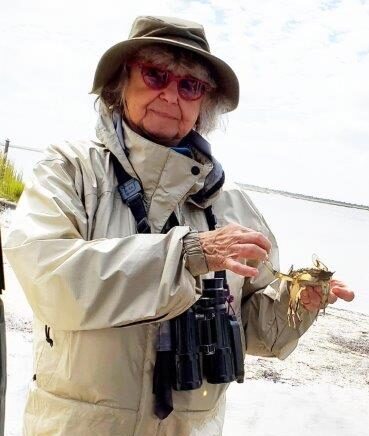Medford Leas birders had scheduled a trip to Island Beach for Sept. 20, but the weather didn’t cooperate. The rain date of Sept. 27 was a lucky, sunny, 65-degree day in between two stretches of clouds due to Tropical Storm Ophelia. The Northeast wind didn’t bring a heavy flight of southbound birds, admittedly. But there were some surprises.
As we walked Reed’s Road, a footpath to the bayside, part of the group found a Merlin, while the other found the day’s only warbler, a Yellow-rumped (Myrtle) warbler. At the beach, there were distant, telescope views of two Brown Pelicans and a Jaeger (perhaps a Parasitic, but too far away).
Lunch was at the Nature Center, sheltered from the wind and surrounded by a whale’s jawbone and butterfly gardens. Birds in the maritime shrubs there included a female Rose-breasted Grosbeak and a very surprising Clay-colored Sparrow. It flew toward the bayside, and when we explored the kayak launch we rediscovered the sparrow, and possibly a second one, along the road.
One of the day’s favorite experiences was a flock of several hundred Tree Swallows which descended on the Bayberry shrubs, fluttering together as they ate the berries without perching. A remarkable sight!
Participants: Dino Fiabane, Holly Hoffman, Pat Kidd, Robert Koch, Elizabeth Larose, Laurie Larson, Kathy Roberts.
Trip List:
1 Canada Goose
2 Rock Pigeon
3 Mourning Dove
4 Sanderling
5 Spotted Sandpiper
6 Willet
7 Parasitic Jaeger
8 Laughing Gull
9 Ring-billed Gull
10 Herring Gull
11 Great Black-backed Gull
12 Caspian Tern
13 Double-crested Cormorant
14 Brown Pelican
15 Great Blue Heron
16 Great Egret
17 Turkey Vulture
18 Osprey
19 Belted Kingfisher
20 Red-bellied Woodpecker
21 Northern Flicker
22 American Kestrel
23 Merlin
24 Blue Jay
25 American Crow
26 Tree Swallow
27 Carolina Wren
28 American Robin
29 Gray Catbird
30 Northern Mockingbird
31 European Starling
32 House Finch
33 Clay-colored Sparrow
34 Eastern Towhee
35 Red-winged Blackbird
36 Yellow-rumped Warbler
37 Northern Cardinal
38 Rose-breasted Grosbeak

Holly found a Blue Crab at the edge of the waters of Barnegat Bay. Crabs are scavengers and hunters, using their claws as tools for opening oysters, clams, and other shellfish. In turn, they become popular seafood for humans. Barnegat Bay suffers from impact of global climate change in many ways, which will affect Blue Crabs.
